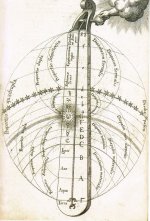I have been looking at the Triumphal Arches for a very long time, for The Stargate movie kept on pushing this crazy idea of teleportation type travel. Just got done spot-watching the Warcraft movie with its Dark Portal, and decided to throw a few words together in reference to them Arches. Ones of the hardest puzzles to crack, they are. There is essentially no valuable information to be obtained via searching for "Triumphal Arch".
Even the oldest of the texts give the most regular information similar to what Wikipedia says. I have a suspicion that way back in the day these "Triumphal Arches" could be known under a different name. As it stands:
- A triumphal arch is a monumental structure in the shape of an archway with one or more arched passageways, often designed to span a road. In its simplest form a triumphal arch consists of two massive piers connected by an arch, crowned with a flat entablature or attic on which a statue might be mounted or which bears commemorative inscriptions. The main structure is often decorated with carvings, sculpted reliefs, and dedications. More elaborate triumphal arches may have multiple archways.
- Triumphal arches are one of the most influential and distinctive types of architecture associated with ancient Rome. Thought to have been invented by the Romans, the triumphal arch was used to commemorate victorious generals or significant public events such as the founding of new colonies, the construction of a road or bridge, the death of a member of the imperial family or the accession of a new emperor.
Triumphal Arches
- Serve no practical purpose
- Serve no defensive purpose
- Not easy to build
500 Gates
The number of the destroyed arches is not exactly known. Researchers only know of the ones they know about, if that makes sense. One way or the other they estimate the number of Arches to ever exist to be close to 500. Chances are, there could be a thousand more, and we will never find out about them. Needless to say that their original spread could only be guessed.We are so gullible, that we accept the most ridiculous of explanations of what some of the "post-Roman" Arches represent. Yet, these Arches incorporate our old friends - Ancient Greek, and Roman characters (pre-Mudflood civilization?). Here is a couple examples of the non-sense we buy.
- USA - Soldiers' and Sailors' Arch - what does it have to do with the US Civil War Soldiers and Sailors?
Arch in 1894 without sculptures

This is a very "Ancient European" looking America...
This is a very "Ancient European" looking America...
- Russia - Triumphal Arch of Moscow - what does it have to do with Napoleonic Wars?
The third and the oldest surviving Triumphal Arch in Moscow was built in 1829–34 on Tverskaya Gate Square to Joseph Bové's designs in order to commemorate Russia's victory over Napoleon. It replaced an earlier wooden structure built by the veterans of the Napoleonic Wars in 1814.
This is a very "Ancient European" looking Russia... minus makeshift accessories
Ianuae Magicae
- [Eng : Latin] Gate - Porta
- [Eng : Latin] Door - Ianuae
- [Eng : Latin] Teleport - Ianuae Magicae
- [Latin : Eng] Ianuae Magicae - The Magic Doors
King Solomon and Co.
From here I thought it would be much more interesting to Google. I thought wrong. Nothing solid came up so far. Apparently, the info on this Ianuae Magicae aka The Magic Doors could have some relation to King Solomon, and may be a derivative of the Knights Templar- Ordo Templi Orientis - Order of the Temple of the East' or 'Order of Oriental Templars'
- Key of Solomon - The Key of Solomon is a pseudepigraphical grimoire attributed to King Solomon. It probably dates back to the 14th- or 15th-century Italian Renaissance. It presents a typical example of Renaissance magic.
- Lesser Key of Solomon - The Lesser Key of Solomon, also known as Clavicula Salomonis Regis or Lemegeton, is an anonymous grimoire (or spell book) on demonology. It was compiled in the mid-17th century, mostly from materials a couple of centuries older.
I'm equally suspicious with anything denied, or questioned by the contemporary science, as is clearly the case with these Solomon Key texts.
A couple of other noteworthy texts:
- Household Words: Conducted by Charles Dickens, Volume 33
- The Rock of Modrec; Or, the Legend of Sir Eltram
KD: Anyways, this is just a little prelim to the research. If we could figure out the name for these "Gates" before they became "Triumphal Arches", we could probably get a bit closer to solving their mystery. Feel free to join in, this is a hard one.


